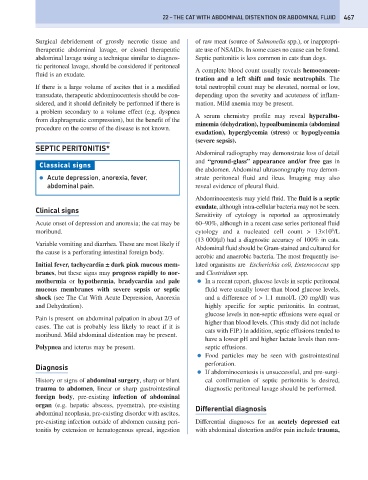Page 475 - Problem-Based Feline Medicine
P. 475
22 – THE CAT WITH ABDOMINAL DISTENTION OR ABDOMINAL FLUID 467
Surgical debridement of grossly necrotic tissue and of raw meat (source of Salmonella spp.), or inappropri-
therapeutic abdominal lavage, or closed therapeutic ate use of NSAIDs. In some cases no cause can be found.
abdominal lavage using a technique similar to diagnos- Septic peritonitis is less common in cats than dogs.
tic peritoneal lavage, should be considered if peritoneal
A complete blood count usually reveals hemoconcen-
fluid is an exudate.
tration and a left shift and toxic neutrophils. The
If there is a large volume of ascites that is a modified total neutrophil count may be elevated, normal or low,
transudate, therapeutic abdominocentesis should be con- depending upon the severity and acuteness of inflam-
sidered, and it should definitely be performed if there is mation. Mild anemia may be present.
a problem secondary to a volume effect (e.g. dyspnea
A serum chemistry profile may reveal hyperalbu-
from diaphragmatic compression), but the benefit of the
minemia (dehydration), hypoalbuminemia (abdominal
procedure on the course of the disease is not known.
exudation), hyperglycemia (stress) or hypoglycemia
(severe sepsis).
SEPTIC PERITONITIS*
Abdominal radiography may demonstrate loss of detail
and “ground-glass” appearance and/or free gas in
Classical signs
the abdomen. Abdominal ultrasonography may demon-
● Acute depression, anorexia, fever, strate peritoneal fluid and ileus. Imaging may also
abdominal pain. reveal evidence of pleural fluid.
Abdominocentesis may yield fluid. The fluid is a septic
exudate, although intra-cellular bacteria may not be seen.
Clinical signs
Sensitivity of cytology is reported as approximately
Acute onset of depression and anorexia; the cat may be 60–90%, although in a recent case series peritoneal fluid
9
moribund. cytology and a nucleated cell count > 13×10 /L
(13 000/μl) had a diagnostic accuracy of 100% in cats.
Variable vomiting and diarrhea. These are most likely if
Abdominal fluid should be Gram-stained and cultured for
the cause is a perforating intestinal foreign body.
aerobic and anaerobic bacteria. The most frequently iso-
Initial fever, tachycardia ± dark pink mucous mem- lated organisms are Escherichia coli, Enterococcus spp
branes, but these signs may progress rapidly to nor- and Clostridium spp.
mothermia or hypothermia, bradycardia and pale ● In a recent report, glucose levels in septic peritoneal
mucous membranes with severe sepsis or septic fluid were usually lower than blood glucose levels,
shock (see The Cat With Acute Depression, Anorexia and a difference of > 1.1 mmol/L (20 mg/dl) was
and Dehydration). highly specific for septic peritonitis. In contrast,
glucose levels in non-septic effusions were equal or
Pain is present on abdominal palpation in about 2/3 of
higher than blood levels. (This study did not include
cases. The cat is probably less likely to react if it is
cats with FIP.) In addition, septic effusions tended to
moribund. Mild abdominal distention may be present.
have a lower pH and higher lactate levels than non-
Polypnea and icterus may be present. septic effusions.
● Food particles may be seen with gastrointestinal
perforation.
Diagnosis
● If abdominocentesis is unsuccessful, and pre-surgi-
History or signs of abdominal surgery, sharp or blunt cal confirmation of septic peritonitis is desired,
trauma to abdomen, linear or sharp gastrointestinal diagnostic peritoneal lavage should be performed.
foreign body, pre-existing infection of abdominal
organ (e.g. hepatic abscess, pyometra), pre-existing
Differential diagnosis
abdominal neoplasia, pre-existing disorder with ascites,
pre-existing infection outside of abdomen causing peri- Differential diagnoses for an acutely depressed cat
tonitis by extension or hematogenous spread, ingestion with abdominal distention and/or pain include trauma,

